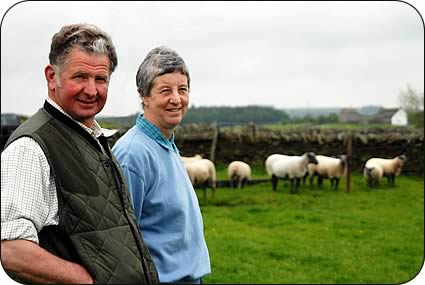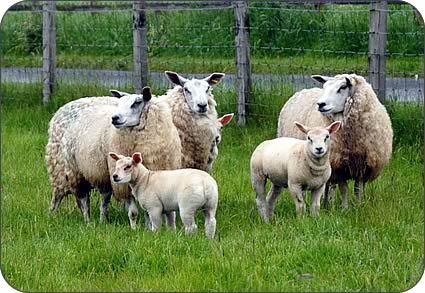Jennifer MacKenzie is an agricultural photo journalist with almost 30 year's experience. Operating from her base in Cumbria, Jennifer undertakes mainly industry-related freelance writing and photography.
Faithful to the Bleu du Maine
The attributes of a prolific, commercial female with length and weight
have kept John and Kathleen Davison faithful to the Bleu du Maine for almost
20 years.
John Davison, who is president of the Bleu du Maine Sheep Society in its
30th anniversary year, first used rams on his North of England Mules to
produce lambs with a leaner carcase than they had been getting with their
previous terminal sire.
 |
| John and Kathleen Davison |
After buying their first Bleu ram in 1990, later that year the Davisons
bought their first three in-lamb females in Carlisle for their pedigree
Langley flock at the 290-acre Lough Green, Langley on Tyne, near Hexham.
Numbers have been built up to today’s 25 breeding ewe flock by selective
breeding with few bought-in females. The flock is now closed to minimise
disease risks.
Now, as well as the Bleu flock, there are 40 pure Texels and 200 commercial
ewes which originated from the Mules but are now predominantly Texel and
Bleu crosses or Texel three quarter bred sheep. Texel and Bleu rams are
used to maintain crossbred ewes.
Home-bred Texel ram lambs from the Lough Green 40-ewe flock are used on
the commercial flock and then sold as shearlings the following year.
Some of the crossbreds are kept as flock replacements but there is a ready
market for the crossbred hoggs with single Texel and Bleu-sired lambs at
foot which are sold in May. This year they averaged more than £125
for 38 sold through Hexham mart to a top price of £148.
“The Bleu ram produced a bigger carcase but we also found that the
female line was a great advantage and we started to retain the Bleu cross
females for the commercial flock, crossing them with the Texel,” said
John Davison.
“The Texel works very well with the Bleu cross females. The Bleu
du Maine is also successful crossed with the Beltex, as has been proven
with the Millennium Bleu which we have a number of,” added Mr Davison.
 |
| Pedigree ewes in the 25-strong Langley flock with their lambs |
“The Bleu has a place on this farm and the crossbred is a good commercial
ewe which more and more people are buying to cross.
“To get a good price from the market which is essential now you have
got to go for conformation. With the Bleu we also get extra length and
weight and we aim to sell up to 45kg liveweight for the crossbred lambs.”
Another successful spin-off is that John always uses Texel rams on a proportion
of his pedigree Bleus and sells them as shearlings at Kelso Ram Sale.
While there was no sale last year because of foot and mouth restrictions,
in 2006 he sold five to average more than £600. This year there are
eight Bleu cross-bred shearling rams to sell at Kelso with 28 pure Texels
for Hexham and three pure Bleu shearlings as well as five lamb rams for
the Carlisle sale.
The Davisons enjoy showing and the competition it brings – for a
number of years they grew and exhibited late flowering chrysanthemums,
winning the national championship, as well as fuchsias and Kathleen travels
hundreds of miles to compete in dog agility events with her collies.
Judging Bleu du Maines has taken John to all corners of the UK and, likewise,
showing.
Last year at the Royal Highland, he won the breed championship with a home-bred
shearling gimmer which was fourth in the interbreed championship as well
as reserve breed champion with an aged ram.
He also had the honour of winning the Paisley Gold Cup, awarded last year
to the Bleu du Maine champion.
The same shearling gimmer went on to win the Yorkshire Show reserve breed
championship as well as the lowland shortwool interbreed female championship.
 |
| Crossbred commercial ewes with lambs. |
At the Royal Welsh she was again breed champion and a home-bred Langley
ram lamb was reserve to her.
At the Northumberland County Show in May this year a home-bred gimmer was
the reserve champion in mixed continental classes.
“The breed went through a decline in popularity in the 1990s, partly
due to its popularity after it first came to the UK in the 1980s resulting
in breeders not being selective enough and the commercial producer wasn’t
getting what he wanted.
“The Bleu has come into its own as a maternal breed. My aim is to
breed a sheep with good teeth, legs and conformation as well as a good
skin which is what the butchers are looking for.”
Success in the show ring has been partly down to Maunby Butch, bought at
the Carlisle society sale in August 2004 as a ram lamb for 2,000gns from
Stuart and Julia Goldie, of Maunby, North Yorkshire, at the time the highest
price paid for a Bleu ram for a number of years.
His progeny has won the Royal Welsh Show for the last three years and the
Highland for the last two years. A ram lamb by him was sold for 2,000gns
through the ring at Carlisle.
“I sold him as a two shear. He was a correct ram – he was big,
had good conformation and a good skin,” said John.
The pedigree flock lambs from early February with ewes being served naturally,
although semen was taken from Butch. The ewes lamb inside and, weather
permitting, are allowed to run outside.
The commercial ewes lamb from the end of March through April, again inside.
“They are very easy to lamb. Because they are quite a fine-boned
sheep with smallish heads we don’t get any difficulties and we have
virtually no deaths at lambing,” said Mr Davison. “They are
also quiet to handle.”
“With the commercial flock we have good conformation females which
are prolific averaging two lambs per ewe and they are very milky,” he
added.
Pedigree lambs are creep fed however, the cross bred lambs are grass reared.
Mr Davison says the Bleu lambs are flexible to finish, having the ability
to put on weight without getting too fat.
The farm runs a herd of 40 Limousin and Belgian Blue suckler cows which
are put to the Limousin.

